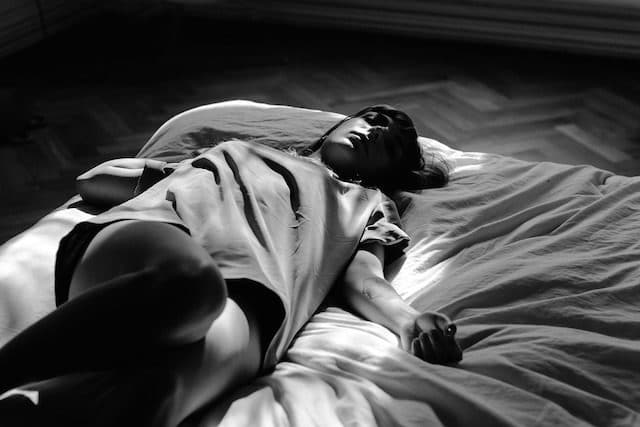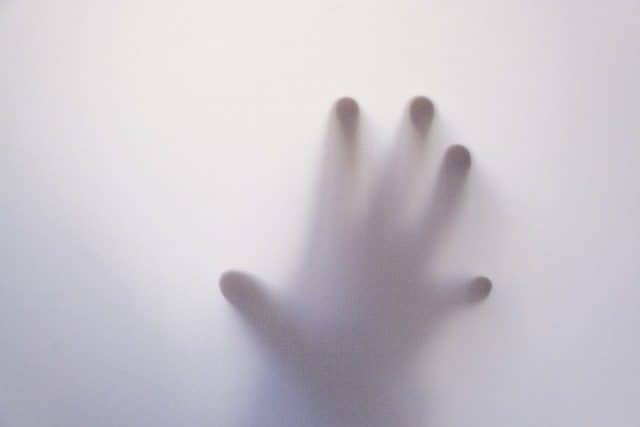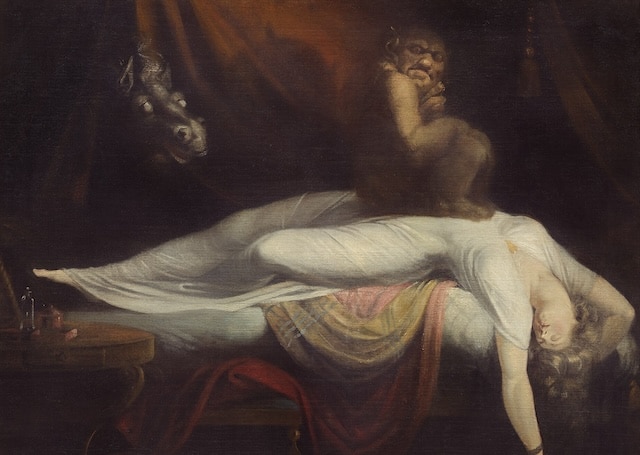If you spend much time on social media these days, you’ve probably run across at least one joke someone has made about a sleep paralysis demon. It makes for a quirky punch line, but it’s not a term pulled out of nowhere. The idea of a sleep paralysis demon has existed for a long time, and it’s actually a very serious thing, even though it sounds like I’ve been a fantasy.
In a very technical way, a sleep paralysis demon is a real thing. That’s not to say it’s a supernatural being that attacks you at night and freezes you in bed, but there’s still something happening when people experience this phenomenon.
What is Sleep Paralysis?

Before we worry too much about creepy demons, it’s worth figuring out what sleep paralysis is. That, in and of itself, is a unique thing that most people will never experience and thus have no frame of reference for.
To start with, sleep paralysis, or muscle atonia, is actually something you do experience, you just probably don’t know it. Everyone experiences sleep paralysis, it’s an important part of the REM phase of sleep. If you didn’t experience sleep paralysis, you might act out the things that you do in your dreams. That can include running, talking, and maybe trying to drive your car. People who have issues with sleepwalking are dealing with a sleep paralysis problem not functioning the way it’s supposed to, so it’s sort of the opposite.
Your brain sends nerve signals through your body to prevent your arms and legs from acting out the events going on in your dreams. Usually, this begins as you’re easing into REM sleep and then fades away as you are coming out of it.
Sleep paralysis becomes a problem when it occurs outside of the REM part of sleep. In these cases, a person can become conscious, and become aware of their surroundings but their body is still paralyzed like it would be during the REM portion of sleep. You cannot move your limbs and you cannot speak. It’s been likened to feeling trapped inside your own body.
If you have never experienced this before, you can imagine what that might be like. You wake up, you feel like things are normal, and then you realize your body isn’t responding to you. Your mind seems clear, but your limbs refuse to work. That already is a terrifying prospect without us having to include the demon part, which will get you shortly.
When you wake enough to have awareness, but the muscle atonia has not gone away, that is sleep paralysis. It’s actually very common for people to experience it at some point in their life. Some estimates suggest 7.6% of people will experience this in their lifetime. However, as many as 40% of people might experience isolated sleep paralysis incidents.
Sleep paralysis can happen in perfectly healthy individuals, but some conditions will also exacerbate it. This includes other sleep disorders like narcolepsy, as well as things like excessive drinking or high levels of stress.
History of Sleep Paralysis and the Paranormal

Imagine a time when science was not quite as refined as it is today. Imagine you live in this world and you wake up one evening, in your own bed, and you can move your eyes, you can sense the world around you, but you can’t do anything else. You can’t sit up for some reason. You can’t call for help. You are trapped inside of your own body and, at the same time, you are very convinced that you are not alone. In an age before science, what would you think is happening?
Given how prevalent sleep paralysis is in the modern world, you could imagine that it was absolutely the same in the past. So let’s go back 500 years to some random individual who wakes up in these conditions. They would likely think something supernatural was going on. It hardly seems like a sickness, and like we said, it can afflict perfectly healthy people. In your mind, you would have no reason to think this was anything with an earthly explanation.
Sleep paralysis has often been paired with the paranormal in people’s minds. There’s more to it than simply being awake and not being able to move. Many people report shallow breathing like they can’t take in a full lung full of air. And for many, this manifests as a feeling of some weight on their chest. Like an unseen thing sitting on you, weighing you down.
The Old English word maere describes a spirit that lies on your chest and tries to suffocate you. This, combined with night, gives us nightmares. In German they called it hexendrücken, cauchemar was the name in France. All names for the same thing.
On the east coast of Canada, it was called Old Hag or Old Hag Syndrome sometimes. The idea was that there was a witch perched on your chest preventing you from moving or breathing properly. The Brazilians have a myth about an old crone named Pisadeira who is responsible. Nigerians have similar beliefs, but it’s a demon woman in those. In Japan, it is a vengeful spirit.
In Hong Kong they call it ghost oppression and, from a descriptive standpoint, it’s exactly the same as sleep paralysis. If you head to Mexico you might learn about the “a dead body climbed on top of me” phenomenon which, sure, isn’t the most catchy name but it’s fairly descriptive and brings to mind good imagery.
Because the experience of sleep paralysis is so universal, there wasn’t really a culture, time, or place where people didn’t experience this. You can find writings on the subject that date back to the 10th century in Persia. As a result, explanations that fit the time were devised. And these supernatural beliefs were all that people could come up with. So demons, witches, and other monsters became the most prevalent explanations.
After all, what else could you use to explain an invisible force weighing you down and preventing you from moving at night? Even today we make movies about sleep paralysis and sleep paralysis demons, they are perfect fodder for the horror genre.
Why Demons?

So if sleep paralysis and its association with the paranormal comes from the past why do we talk about sleep paralysis demons today? Especially when we have science and we can explain why these things happen. Why are you going to get millions of results if you Google sleep paralysis demon right now?
You can blame this on your brain. Remember, this happens when you’re sleeping. The problem isn’t only that your body can’t move, it’s also that you’re aware. Neither one of those things should happen together. When they do, your awareness is still happening in the process of sleep, likely going into or coming out of REM and that’s when you dream. So you can suffer from vivid hallucinations at this time.
Your brain is telling you that you are awake, but it’s also functioning on that sleep level at the same time and those two worlds don’t do well together. This is a recipe for something called hypnopompic hallucinations or hypnagogic hallucinations depending on if they happen as you wake or fall asleep. These are things you see that are not real, like mistaking a coat in the corner for the boogeyman, but seem real in the moment.
Because you’re conscious when these happen, they don’t qualify the dreams. They are hallucinations. They can be visual, but you can also be tactile, aural, or even olfactory. You could be smelling something that isn’t there, or hearing it creeping towards you in the dark. It may only last a few seconds, or it may take several long, excruciating minutes.
While not everyone experiences hallucinations, and not always visual ones, some people do. Some people have legitimately seen demons, witches, and other creatures sitting on them or lurking in their rooms. Your imagination can easily fill in the blanks here, and if it’s a frightening situation already, and you see movement, here noises, you’re probably going to imagine the worst.
Ghosts, demons, vampires, these kinds of things are all common. One theory about why you see unsettling and supernatural things relates to how those chemicals that paralyze your body affect your mind. Because some people also report feeling out-of-body type experiences, there can be a separation of self occurring, like you feel you are not rooted in your body any longer. When this happens, you feel a sense of detachment between you and something outside of you.
Your brain is going to send signals to your body to move. You’re experiencing something you don’t like and you want to flee. But at the same time, other parts of your brain are registering that you are not moving. And if you do not have that same sense of self that you do normally when you’re awake and moving around, your brain might fill in the blanks in the wrong way.
Research has shown that people who are born without limbs can still experience phantom limb syndrome. This has led to the theory that our minds are hardwired to understand the shape of a human body. We have, in our heads, a map of what we should look like.
During sleep paralysis, when your brain is telling you to move and you’re not moving, other parts of your brain can recreate that map. Essentially, creating a double of you, in your mind. Except, you’re stuck in your mind right now, too, half between wakefulness and sleep, and that creates the hallucination of another being, this one fully capable of moving.
Unfortunately, it’s rarely something as simple as a duplicate of yourself. The mind doesn’t work like that, and because of the heightened sense of terror, it’s often something horrible that the victim sees. The upside is that, for most people, this will be an isolated incident.
Those who suffer from it chronically, however, have a much tougher road to travel because the sensations always seem real at the time they’re happening. Like any nightmare, when you wake up you can recognize that it was all a dream, but that doesn’t change the fact that you woke up screaming in a cold sweat. At the time, you were terrified.
The Nightmare Incubus

Henry Fuseli painted the famous work known as The Nightmare in 1781. The painting depicts a woman on a bed with a little incubus demon perched upon her chest. This image has become synonymous with the idea of a sleep-paralysis demon. It is very representative of the sensation people report experiencing.
This painting has become famous and serves as one of the best, classical visual representations of the idea of a sleep paralysis demon. At the time the work was considered very erotic, you can see for yourself that there are some sexual connotations to it.
That’s also a theme that continues to be present in sleep paralysis hallucinations for many people in modern times. There is sometimes the sense of being victimized by this entity that visits you in your sleep, which likely accounts for legends of things like the incubus and the succubus which are said to take advantage of their sleeping prey in a sexual manner.
So while it may be hard to keep in mind, especially given the circumstances, if you should ever find yourself in a sleep paralysis situation just know that whatever you think you see, whatever you think you feel or hear in the room, is probably not there with you.
… Probably.